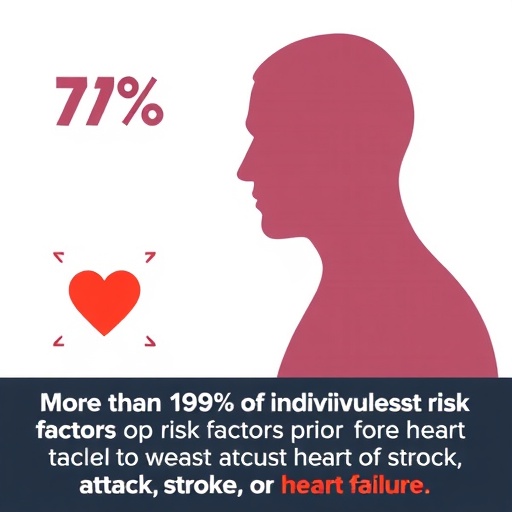A groundbreaking investigation conducted by researchers from Northwestern Medicine and Yonsei University in South Korea has unveiled compelling evidence that nearly every individual who experiences a major cardiovascular event has exhibited at least one elevated risk factor well before the onset of disease symptoms. Through an unprecedented analysis involving over nine million South Korean adults and nearly seven thousand from the United States, this extensive longitudinal study challenges the longstanding notion that heart attacks, strokes, and heart failure often strike without pre-existing warning signs.
The study meticulously evaluated traditional cardiovascular risk markers—blood pressure, cholesterol, blood glucose, and tobacco use—employing definitions aligned with the American Heart Association’s criteria for ideal cardiovascular health. Risk factors were characterized as nonoptimal if blood pressure readings were at or exceeded 120/80 mm Hg or were under treatment, total cholesterol was 200 mg/dL or higher, fasting glucose was 100 mg/dL or more (including diagnosed diabetes or treatment), and if the subject had a history of tobacco use. This framework allowed the researchers to gauge the prevalence of subclinical risk factor elevation years prior to first-time cardiovascular incidents, spanning up to two decades of health record tracking.
Remarkably, analysis revealed that more than 99% of study participants who subsequently suffered coronary heart disease, heart failure, or stroke had at minimum one of these risk categories above the optimal threshold before their cardiac event. Multiple risk factors were overwhelmingly prevalent, with over 93% of individuals presenting two or more modifiable risk determinants. These findings were consistent across diverse demographics and geographical cohorts, highlighting a ubiquitous pattern of chronic exposure to cardiovascular stressors preceding clinical manifestation.
Hypertension emerged as the predominant risk factor, significantly affecting more than 95% of the Korean cohort and over 93% of the American cohort prior to cardiovascular incidents. This insight underscores the critical role of blood pressure regulation in the prevention of cardiac events. Even more strikingly, segments conventionally considered low-risk, such as women under 60 years of age, demonstrated a similarly high burden of at least one nonoptimal cardiovascular factor. This dispels myths about silent vulnerability and emphasizes the protective potential of early risk identification.
Delving deeper, researchers extended the scrutiny to clinically elevated parameters—those meeting thresholds used for explicit medical diagnoses: blood pressure at or above 140/90 mm Hg, cholesterol levels exceeding 240 mg/dL, fasting glucose readings of 126 mg/dL or higher, and active smoking status. Intriguingly, nearly 90% of affected patients qualified for having at least one clinically significant risk factor, highlighting the prevalence of both subclinical and clinical risk factors as harbingers of cardiovascular disease onset.
The implications of the study are profound for the medical community and public health strategists. By definitively validating the near-universal presence of modifiable risk indicators well before cardiovascular events occur, the research advocates for enhanced surveillance protocols and aggressive risk factor mitigation strategies. It cautions against diverting attention to nonmodifiable or obscure determinants that may dilute focus and resources from controlling primary, treatable risk metrics.
Senior author Dr. Philip Greenland, a professor of cardiology at Northwestern University Feinberg School of Medicine, emphasized the urgency of refocusing cardiovascular preventive efforts. He articulated that the overwhelming consistency of risk factor prevalence before disease onset mandates a strategic pivot toward earlier detection, lifestyle modification, and medication adherence designed to optimize blood pressure, cholesterol, glycemic control, and cessation of tobacco use.
Methodologically, the study’s expansive sample size and comprehensive follow-up periods provide unprecedented statistical power and robustness. The Korean National Health Insurance Service dataset, combining repeated health assessments, created an ideal vantage point to track temporal risk factor trajectories in a massive population. Parallel analysis of U.S. cohort data further corroborated the generalizability of findings across ethnic and healthcare system boundaries, reinforcing the global relevance of cardiovascular risk management.
This research offers a paradigm shift in understanding the pathophysiology of cardiovascular illness, emphasizing exposure duration and cumulative risk burden rather than episodic or spontaneous event triggers. It provides a compelling rationale for routine, population-wide screening programs to identify nonoptimal risk factor control long before symptomatic disease arises, potentially averting morbidity and mortality through preemptive intervention.
Moreover, the findings fuel important discussions about health equity and access, confirming that widespread risk factor elevation is not confined to any demographic but is nearly universal among those who develop cardiovascular disease. This underscores the criticality of inclusive public health policies and targeted outreach to promote awareness, education, and equitable healthcare delivery.
The study, titled “Very High Prevalence of Nonoptimally Controlled Traditional Risk Factors at the Onset of Cardiovascular Disease,” was published in the Journal of the American College of Cardiology on September 29, 2025. Funded by the National Research Foundation of Korea, the research exemplifies international collaboration that harnesses big data analytics to unravel health patterns with transformative clinical implications.
In essence, this landmark inquiry dismantles myths surrounding the silent onset of cardiovascular catastrophes, replacing them with evidence that modifiable risk factors are pervasive and present long before disease culmination. With cardiovascular disease remaining the leading cause of death globally, these insights kindle renewed vigor and strategic focus on proactive risk factor management as the cornerstone of effective cardiovascular disease prevention.
Subject of Research: Cardiovascular risk factors and their prevalence before first cardiovascular events
Article Title: Very High Prevalence of Nonoptimally Controlled Traditional Risk Factors at the Onset of Cardiovascular Disease
News Publication Date: 29-Sep-2025
Web References: http://dx.doi.org/10.1016/j.jacc.2025.07.014
References: American Heart Association’s ideal cardiovascular health definitions (https://www.ahajournals.org/doi/10.1161/circulationaha.109.192703)
Keywords: Cardiovascular disorders, Risk factors, Heart disease, Heart failure, Myocardial infarction, Hypertension




